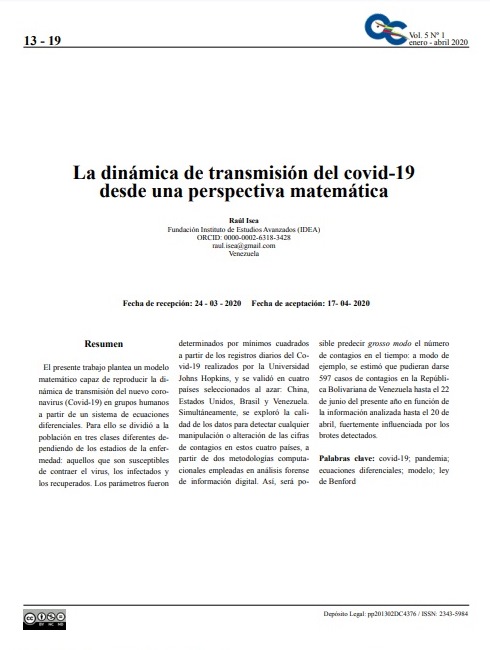The Transmission Dynamics of Covid-19 from a Mathematical Perspective
Keywords:
Covid-19; pandemic; model; outbreak; Benford lawAbstract
The present work proposes a Mathematical model capable of reproducing the transmission dynamics of the new coronavirus (Covid-19) in human groups, from a system of differential equations. The total population was divided into three different types: susceptible, infected, and recovered. Parameters were developed using the least squared method, based on Johns Hopkins’ Covid-19 data, and were validated in four countries: China, the United States, Brazil and Venezuela. Simultaneously, the quality of the data was explored to detect any manipulation or alteration of the numbers of infections in these four countries, based on two computational methodologies used in forensic analysis of digital information. Finally, it will be possible to estimate that 597 cases of infection could occur in the Bolivarian Republic of Venezuela, until June 22 of this year, based on the information analyzed up to April 20, heavily influenced by the detected break out.
Downloads
References
Alexander, J. C. (2009). Remarks on the use of Benford’s Law. En Red. Disponible en SSRN, 1505147.
Feng, Z. (2007). Final and peak epidemic sizes for SEIR models with quarantine and isolate. Mathematical Biosciences and Engineering, 4(4): 675-686.
Fewster, R. M. (2009). A simple explication of Benford’s Law. The American Statistician, 63(1): 26-32.
Forman, A. K. (2010). The Newcomb-Benford law in its relation to some common distributions. PLoS ONE, 5, e10541.
Huang, Y.; Yang, L.; Dai, H.; Tian, F. & Chen, K. (2020). Epidemic situation and forescasting of COVID-19 in and outside China. DOI: Recuperado en: http://dx.doi.org/10.2471/BLT.20.251561.
Isea, R. (2016). A Preliminary Mathematical Model for the Dynamic Transmission of Dengue, Chikungunya and Zika. American Journal of Modern Physics and Application, 3(2): 11.
Isea, R. (2018). Analytical solutions for the initial steps of the intracellular dynamics of influenza virus. Acta Scientific Microbiology, 1(6): 6-8.
Isea, R. (2019). Modelando la relación de pareja con ayuda de ecuaciones diferenciales. Revista Electrónica, Conocimiento Libre y Licenciamiento, 10(19): 94-98.
Isea, R. & Lonngren, K. E. (2015). A Mathematical Model of Cancer under Radiotherapy. International J. of Public Health Research, 5(3): 340.
Isea, R. y Lonngren, K. E. (2017). A New Variant of the SEIZ Model to Describe the Spreading of a Rumor. International Journal of Data Science and Analysis, 3(4): 28-31.
Isea, R. y Lonngren, K. E. (en prensa). A mathematical model that could explain the social dynamics in a country. Ciencia en Revolución, 6(17).
Zhang, J. (2020). Testing Case Number of Coronavirus Disease 2019 in China with Newcomb-Benford Law. Extraído el 13 febrero, 2020 de arXiV: 2002.05696.

Downloads
Published
How to Cite
Issue
Section
License

This work is licensed under a Creative Commons Attribution-NoDerivatives 4.0 International License.







